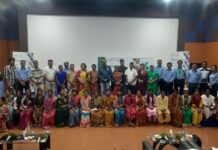By Suhas Chakma
NEW DELHI:Releasing the report, “The State of Female Infanticide in Himachal Pradesh” , Asian Centre for Human Rights stated that child sex ratio (CSR) has seriously declined from 982 females per 1000 boys (0-6 years) in 1971, the period before the use of the ultrasound machines for sex selection and abortion, to 909 in 2011 in Himachal Pradesh.
However, the State Government of Himachal Pradesh has no seriousness to combat female foeticide despite CSR falling below 500 in at least 24 panchayats of Una district bordering Punjab. All the top five districts of the State with lowest CSR i.e. Una (870), Kangra (873), Hamirpur (881), Bilaspur (893) and Solan (899) are either bordering or near to Punjab which has the second lowest CSR in India as per 2011 census.
The efforts of the Himachal Pradesh government to retain the girl child are non-serious. Under the Beti Hai Anmol Yojana, the flagship scheme to combat female foeticide, the State government provides a meager Rs 5,100 in fixed deposit as post birth benefit to Below Poverty Line parents having upto two girl children in the family and the beneficiary girl child is expected to get Rs 23,585 after 18 years at the current interest rate of 9%.
“The amount is too meager to be an incentive even for the BPL families for retention of girl child. The Beti Hai Anmol Yojana excludes those above the poverty line, middle class and upper class who have been found to resort to abortion of the female fetuses. Further, dowry being the primary cause of female foeticide, the scheme does not provide any assistance for marriage to the beneficiary girls as provided by the State Government of Goa under its Ladli scheme”. – stated Asian Centre for Human Rights.
The coverage of the Beti Hai Anmol Yojana is extremely limited. The Comptroller & Auditor General of India in its latest report on “Social, General and Economic Sectors (Non-Public Sector Undertakings) for the year ending on 31 March 2014” noted that against 18,222 beneficiaries identified during 2011-14 under post birth grant, only 13,332 beneficiaries were covered while 4,890 beneficiaries comprising 27% remained deprived of the intended benefits despite the sanctioning of the funds.
“The report of the CAG is far from the truth. As per information provided by the Himachal Pradesh Government under the Right to Information Act to the Asian Centre for Human Rights (ACHR), only 5,930 beneficiaries were given post birth assistance under the Beti Hai Anmol Yojana upto 2014-2015”.- further stated ACHR.
The Utilization Certificates provided by the Child Development Project Officers of Himachal Pradesh for the Beti Hai Anmol Scheme are without date, signature and stamp of the concerned officer and raise serious doubts as to whether benefits are actually reaching to the beneficiaries.
Despite rampant female foeticide, only one conviction under the Preconception and Pre-Natal Diagnostic Techniques (Prohibition of Sex Selection) Act, 1994 (PCPNDT Act) was secured in Himachal Pradesh during 2009 to December 2014.
Asian Centre for Human Rights recommended to the State Government of Himachal Pradesh to revise the Beti Hai Anmol Yojana to increase the amount for post birth benefits and scholarship, and further to provide additional financial assistance of Rs 1 lakh for marriage to beneficiary girl similar to the amount provided under the Ladli Scheme of Goa; expand the coverage of the Beti Hai Anmol Yojana to include families irrespective of income and to all girl children in the family and not upto two daughters only; link the Beti Hai Anmol Yojana with all hospitals/primary health centres, Anganwadi Centres and schools to monitor the status of the beneficiaries; digitalise the list of beneficiaries and related information, funds sanctioned and utilization certificates and upload the same in the website of the District concerned and ensure proper implementation of the PCPNDT Act….(The writer Suhas Chakma, is Director of New Delhi based Asian Centre for Human Rights).






















